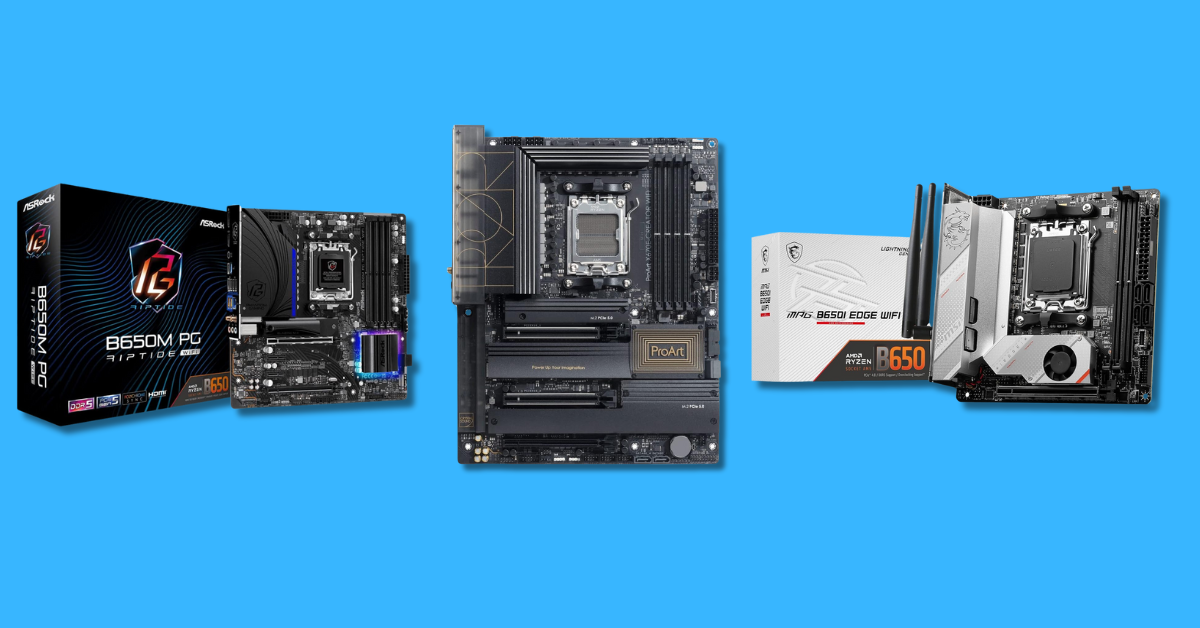In the realm of AMD processors, the Ryzen 7 7800X3D stands out as a powerhouse, demanding a motherboard that can fully harness its capabilities. Join us on a journey to explore and discover the best motherboards tailored to unlock the full potential of the Ryzen 7 7800X3D, providing a foundation for unparalleled speed, efficiency, and reliability in your computing experience.
| IMAGE | PRODUCT | FEATURES | PRICE |
|---|---|---|---|
EDITORS CHOICE
 | ASRock X670E Taichi |
| Check on Amazon |
BUDGET PICK
 | GIGABYTE B650 AORUS Elite |
| Check on Amazon |
TOP CHOICE
 | ASUS ROG Crosshair X670E Hero |
| Check on Amazon |
 | MSI MPG B650I Edge |
| Check on Amazon |
 | ASRock B650M PG Riptide |
| Check on Amazon |
 | ASUS ROG Strix B650E-F |
| Check on Amazon |
 | NZXT N7 B650E – N7-B65XT-W1 |
| Check on Amazon |
 | ASUS ProArt X670E AM5 ATX |
| Check on Amazon |
Table of Contents
Best motherboards for Ryzen 7 7800X3D
1. ASRock X670E Taichi

1. Design and Build Quality:
The first impression of the ASRock X670E Taichi is its design and build quality. Evaluate the construction, layout, and overall aesthetics. Pay attention to the quality of components and the durability of the motherboard.
2. Performance:
Assess the motherboard’s performance in handling tasks, gaming, and multitasking. Consider the support for overclocking and the stability of the system under different workloads.
3. Compatibility and Connectivity:
Examine the compatibility with various hardware components, including processors, RAM, and GPUs. Evaluate the available PCIe slots, USB ports, and other connectivity options for peripherals.
4. BIOS/UEFI Interface:
Explore the BIOS/UEFI interface for user-friendliness, customization options, and accessibility of features. A clear and intuitive interface can greatly enhance the user experience.
5. Features:
Identify and analyze the unique features offered by the ASRock X670E Taichi. Look for features such as Wi-Fi support, advanced audio solutions, RGB lighting options, and any other distinctive functionalities.
6. Cooling Solutions:
Assess the effectiveness of the cooling solutions integrated into the motherboard. Evaluate the ability to keep temperatures in check, especially if you plan on overclocking your system.
7. Value for Money:
Consider the overall value for money the motherboard provides. Compare its price to the features offered and how it competes with other models in the same price range.
8. Customer Support and Warranty:
Investigate the customer support services provided by ASRock and the warranty terms for the X670E Taichi. A reliable support system is crucial in case issues arise.
9. User Feedback:
Check for user reviews and experiences with the ASRock X670E Taichi. Real-world feedback from users can provide insights into any potential issues or advantages of the motherboard.
Remember, this is a general guideline, and for the most accurate and updated information about the ASRock X670E Taichi, it’s recommended to check the latest reviews and specifications from reliable sources or contact ASRock directly.
2. GIGABYTE B650 AORUS Elite AX

1. Design and Build Quality:
The GIGABYTE B650 AORUS Elite AX boasts a visually striking design with attention to build quality. Assess the sturdiness, layout, and overall aesthetics of the motherboard. Consider the durability of components and the general craftsmanship.
2. Performance:
Evaluate the motherboard’s performance under various workloads, including gaming, multitasking, and productivity. Consider the support for Intel’s B650 chipset and assess the system’s stability, particularly in demanding scenarios.
3. Compatibility and Connectivity:
Examine compatibility with a range of hardware components, such as CPUs, RAM, and GPUs. Evaluate the number and types of PCIe slots, USB ports, and other connectivity options to ensure compatibility with your desired peripherals.
4. BIOS/UEFI Interface:
Explore the BIOS/UEFI interface for ease of use, customization options, and accessibility of features. A well-designed and intuitive interface enhances the user experience, especially for those tweaking settings or overclocking.
5. Features:
Identify and analyze unique features provided by the GIGABYTE B650 AORUS Elite AX. This may include Wi-Fi support, advanced audio solutions, RGB lighting options, and other functionalities that set it apart from other motherboards in its class.
6. Cooling Solutions:
Assess the effectiveness of the cooling solutions integrated into the motherboard. Evaluate how well it manages temperatures, particularly if you plan on overclocking your system. Look for additional fan headers and cooling features.
7. Value for Money:
Consider the overall value proposition of the motherboard. Compare its price against the features offered and how it stacks up against other motherboards in the same price range. Assess whether the features meet your requirements.
8. Customer Support and Warranty:
Investigate the quality of customer support provided by GIGABYTE and the terms of the warranty for the B650 AORUS Elite AX. A reliable support system is crucial in addressing any potential issues that may arise during or after the installation.
9. User Feedback:
Check for user reviews and experiences with the GIGABYTE B650 AORUS Elite AX. Real-world feedback from users can provide valuable insights into the motherboard’s performance, reliability, and any potential issues that may not be immediately apparent.
Keep in mind that hardware information may change, so for the most accurate and up-to-date details about the GIGABYTE B650 AORUS Elite AX, it’s recommended to check the latest reviews, specifications, and official documentation from GIGABYTE or other reliable sources.
3. ASUS ROG Crosshair X670E Hero Review:
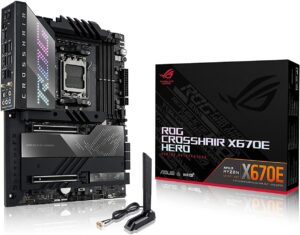
1. Design and Build Quality:
Evaluate the design aesthetics and build quality of the ASUS ROG Crosshair X670E Hero. Assess the overall construction, component quality, and the durability of the motherboard.
2. Performance:
Examine the motherboard’s performance, considering its compatibility with the AMD Ryzen platform. Assess its capability in handling gaming, multitasking, and productivity workloads. Evaluate features that contribute to overall system performance.
3. Compatibility and Connectivity:
Check compatibility with various hardware components, including CPUs, RAM, and GPUs. Evaluate the available PCIe slots, USB ports, and other connectivity options for peripherals. Consider any additional features that enhance compatibility.
4. BIOS/UEFI Interface:
Explore the BIOS/UEFI interface for user-friendliness, customization options, and accessibility of features. A robust and intuitive interface is essential for enthusiasts, especially those interested in overclocking or tweaking advanced settings.
5. Features:
Identify and analyze unique features offered by the ASUS ROG Crosshair X670E Hero. This may include advanced overclocking capabilities, enhanced audio solutions, RGB lighting options, and other functionalities that set it apart in the ROG lineup.
6. Cooling Solutions:
Assess the effectiveness of the cooling solutions integrated into the motherboard. Evaluate the thermal management system and its ability to keep temperatures in check, particularly during overclocking scenarios.
7. Value for Money:
Consider the overall value proposition of the motherboard. Compare its price to the features offered and assess how well it competes with other motherboards in a similar price range. Evaluate whether the features align with your specific requirements.
8. Customer Support and Warranty:
Investigate the quality of customer support provided by ASUS and the terms of the warranty for the ROG Crosshair X670E Hero. A responsive support system is crucial for addressing potential issues promptly.
9. User Feedback:
Check for user reviews and experiences with the ASUS ROG Crosshair X670E Hero. Real-world feedback from users can provide valuable insights into the motherboard’s performance, reliability, and any potential issues that may arise.
For the latest and most accurate information, consult the official ASUS website, product documentation, and user reviews from reliable sources.
4. MSI MPG B650I EDGE WIFI Review:
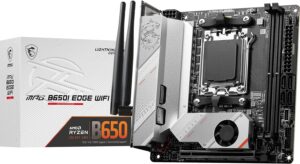
1. Design and Build Quality:
The MSI MPG B650I EDGE WIFI features a compact Mini-ITX design. Assess the overall build quality, component durability, and the aesthetics of the motherboard. Consider the layout and placement of components for ease of installation.
2. Performance:
Evaluate the motherboard’s performance under various workloads, considering its compatibility with Intel’s B650 chipset. Assess its capability for gaming, multitasking, and productivity, ensuring it meets the performance expectations for its form factor.
3. Compatibility and Connectivity:
Examine compatibility with a variety of hardware components, including CPUs, RAM, and GPUs. Evaluate the available PCIe slots, USB ports, and other connectivity options, with specific attention to the inclusion of Wi-Fi for wireless connectivity.
4. BIOS/UEFI Interface:
Explore the BIOS/UEFI interface for user-friendliness, customization options, and accessibility of features. A user-friendly interface is essential, particularly for Mini-ITX builds where space may be limited. Check for overclocking options and system tuning features.
5. Features:
Identify and analyze the unique features offered by the MSI MPG B650I EDGE WIFI. This may include the integrated Wi-Fi module, audio solutions, RGB lighting options, and other functionalities that enhance its appeal for users building compact systems.
6. Cooling Solutions:
Assess the effectiveness of the cooling solutions integrated into the motherboard. Evaluate how well it manages temperatures in a smaller form factor and consider the availability of additional fan headers for optimal thermal performance.
7. Value for Money:
Consider the overall value proposition of the motherboard in relation to its price. Compare its features against other Mini-ITX motherboards in a similar price range. Evaluate whether the features align with your specific requirements and justify the cost.
8. Customer Support and Warranty:
Investigate the quality of customer support provided by MSI and the terms of the warranty for the MPG B650I EDGE WIFI. A reliable support system is crucial for addressing potential issues, and a solid warranty adds to the overall user confidence.
9. User Feedback:
Check for user reviews and experiences with the MSI MPG B650I EDGE WIFI. Real-world feedback from users can provide valuable insights into the motherboard’s performance, reliability, and any potential issues that may not be immediately apparent.
Always verify the latest information by checking the official MSI website, product documentation, and user reviews from reputable sources for the most accurate and up-to-date details about the MSI MPG B650I EDGE WIFI.
5. ASRock B650M PG Riptide WiFi Review:
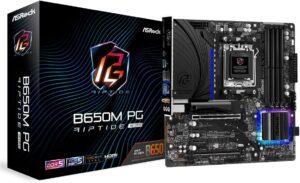
1. Design and Build Quality:
The ASRock B650M PG Riptide WiFi features a microATX form factor. Evaluate the design aesthetics, build quality, and the overall layout of the motherboard. Consider the durability of components and the ease of installation.
2. Performance:
Assess the motherboard’s performance under various workloads, taking into account its compatibility with Intel’s B650 chipset. Evaluate its capabilities for gaming, multitasking, and productivity, ensuring it meets the performance expectations for its form factor.
3. Compatibility and Connectivity:
Examine compatibility with a variety of hardware components, including CPUs, RAM, and GPUs. Evaluate the available PCIe slots, USB ports, and other connectivity options. Special attention should be given to the inclusion of onboard Wi-Fi for wireless connectivity.
4. BIOS/UEFI Interface:
Explore the BIOS/UEFI interface for user-friendliness, customization options, and accessibility of features. A user-friendly interface is essential, and features like overclocking options and system tuning should be readily available.
5. Features:
Identify and analyze unique features offered by the ASRock B650M PG Riptide WiFi. This may include integrated Wi-Fi capabilities, audio solutions, RGB lighting options, and other functionalities that enhance its value proposition.
6. Cooling Solutions:
Assess the effectiveness of the cooling solutions integrated into the motherboard. Consider the thermal management system’s ability to handle heat, and check for additional fan headers or cooling options to optimize the overall system temperature.
7. Value for Money:
Consider the overall value proposition of the motherboard in relation to its price. Compare its features against other microATX motherboards in a similar price range. Assess whether the features align with your specific requirements and if the cost is justified.
8. Customer Support and Warranty:
Investigate the quality of customer support provided by ASRock and the terms of the warranty for the B650M PG Riptide WiFi. A reliable support system is crucial for addressing potential issues, and a solid warranty adds to the overall user confidence.
9. User Feedback:
Check for user reviews and experiences with the ASRock B650M PG Riptide WiFi. Real-world feedback from users can provide valuable insights into the motherboard’s performance, reliability, and any potential issues that may not be immediately apparent.
Always verify the latest information by checking the official ASRock website, product documentation, and user reviews from reputable sources for the most accurate and up-to-date details about the ASRock B650M PG Riptide WiFi.
6. ASUS ROG Strix B650E-F Gaming WiFi Review:
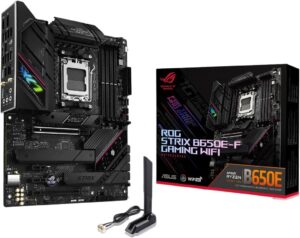
1. Design and Build Quality:
The ASUS ROG Strix B650E-F Gaming WiFi boasts a distinctive design within the ROG Strix series. Evaluate the build quality, design aesthetics, and the overall layout of the motherboard. Consider the durability of components and the attention to detail.
2. Performance:
Assess the motherboard’s performance, taking into account its compatibility with Intel’s B650 chipset. Evaluate its capabilities for gaming, multitasking, and productivity, ensuring it aligns with the performance expectations of gaming enthusiasts.
3. Compatibility and Connectivity:
Examine compatibility with a range of hardware components, including CPUs, RAM, and GPUs. Evaluate the available PCIe slots, USB ports, and other connectivity options. Special attention should be given to the integrated Wi-Fi capabilities for seamless wireless connectivity.
4. BIOS/UEFI Interface:
Explore the BIOS/UEFI interface for user-friendliness, customization options, and accessibility of features. A robust and intuitive interface is crucial, especially for gamers who might delve into overclocking or advanced system tuning.
5. Features:
Identify and analyze the unique features offered by the ASUS ROG Strix B650E-F Gaming WiFi. This may include advanced gaming-centric features, robust audio solutions, RGB lighting options, and other functionalities that enhance its appeal within the ROG Strix lineup.
6. Cooling Solutions:
Assess the effectiveness of the cooling solutions integrated into the motherboard. Evaluate the thermal management system’s ability to handle heat, and check for additional fan headers or cooling options for enthusiasts looking to optimize the overall system temperature.
7. Value for Money:
Consider the overall value proposition of the motherboard in relation to its price. Compare its features against other motherboards in a similar category. Assess whether the features align with your specific gaming and performance requirements and if the cost is justified.
8. Customer Support and Warranty:
Investigate the quality of customer support provided by ASUS and the terms of the warranty for the ROG Strix B650E-F Gaming WiFi. A responsive support system is crucial for addressing potential issues, and a solid warranty adds to the overall user confidence.
9. User Feedback:
Check for user reviews and experiences with the ASUS ROG Strix B650E-F Gaming WiFi. Real-world feedback from users can provide valuable insights into the motherboard’s gaming performance, reliability, and any potential issues that may arise.
Always verify the latest information by checking the official ASUS website, product documentation, and user reviews from reputable sources for the most accurate and up-to-date details about the ASUS ROG Strix B650E-F Gaming WiFi.
7. NZXT N7 B650E Gaming Wi-Fi 6 Motherboard Review:
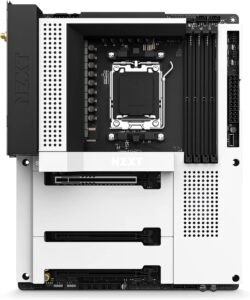
1. Design and Build Quality:
The NZXT N7 B650E Gaming Wi-Fi 6 Motherboard is known for its sleek and minimalist design. Evaluate the build quality, aesthetics, and overall layout. Consider the durability of components and NZXT’s attention to design details.
2. Performance:
Assess the motherboard’s performance, taking into account its compatibility with Intel’s B650 chipset. Evaluate its capabilities for gaming, multitasking, and productivity, focusing on features designed to enhance overall system performance.
3. Compatibility and Connectivity:
Examine compatibility with various hardware components, such as CPUs, RAM, and GPUs. Evaluate the available PCIe slots, USB ports, and other connectivity options. Special attention should be given to the inclusion of Wi-Fi 6 for high-speed wireless connectivity.
4. BIOS/UEFI Interface:
Explore the BIOS/UEFI interface for user-friendliness, customization options, and accessibility of features. NZXT is known for its intuitive user interfaces; ensure that overclocking and system tuning options are readily available.
5. Features:
Identify and analyze unique features offered by the NZXT N7 B650E, such as NZXT’s signature CAM software integration, advanced audio solutions, RGB lighting options, and any other functionalities that set it apart in the gaming motherboard category.
6. Cooling Solutions:
Assess the effectiveness of the cooling solutions integrated into the motherboard. Evaluate how well it manages heat, considering NZXT’s reputation for efficient cooling solutions. Check for additional fan headers or cooling options for enthusiasts.
7. Value for Money:
Consider the overall value proposition in relation to the motherboard’s price. Compare its features against other gaming motherboards in a similar price range. Assess whether the NZXT N7 B650E aligns with your specific gaming requirements and if the cost is justified.
8. Customer Support and Warranty:
Investigate the quality of customer support provided by NZXT and the terms of the warranty for the N7 B650E. Responsive support is crucial for addressing potential issues, and a solid warranty adds to user confidence in the product.
9. User Feedback:
Check for user reviews and experiences with the NZXT N7 B650E Gaming Wi-Fi 6 Motherboard. Real-world feedback from users can provide valuable insights into its gaming performance, reliability, and any potential issues that may arise.
Always verify the latest information by checking the official NZXT website, product documentation, and user reviews from reputable sources for the most accurate and up-to-date details about the NZXT N7 B650E Gaming Wi-Fi 6 Motherboard.
8. Asus ProArt X670E-Creator Review:

1. Design and Build Quality:
The Asus ProArt X670E-Creator showcases a design tailored for creative professionals. Evaluate the build quality, aesthetics, and the overall layout of the motherboard. Consider the durability of components and Asus’ attention to detail in catering to the needs of content creators.
2. Performance:
Assess the motherboard’s performance, taking into account its compatibility with the Intel X670 chipset. Explore its capabilities for content creation tasks, including video editing, 3D rendering, and other demanding workflows. Consider features that enhance overall system performance for creative endeavors.
3. Compatibility and Connectivity:
Examine compatibility with various hardware components, such as CPUs, RAM, and GPUs. Evaluate the available PCIe slots, USB ports, and other connectivity options. Given its ProArt branding, ensure compatibility with professional-grade peripherals and equipment commonly used in content creation.
4. BIOS/UEFI Interface:
Explore the BIOS/UEFI interface for user-friendliness, customization options, and accessibility of features. Creative professionals may appreciate a well-designed interface with advanced options for system tuning and stability.
5. Features:
Identify and analyze unique features offered by the Asus ProArt X670E-Creator. This may include specialized audio solutions, high-speed storage options, Thunderbolt support, and other functionalities tailored to the specific needs of content creators.
6. Cooling Solutions:
Assess the effectiveness of the cooling solutions integrated into the motherboard. Consider how well it manages thermals, especially under heavy workloads. Additional cooling features may be crucial for maintaining system stability during prolonged creative sessions.
7. Value for Money:
Consider the overall value proposition in relation to the motherboard’s price. Compare its features against other motherboards in a similar category, keeping in mind the targeted audience of creative professionals. Evaluate whether the features align with the specific requirements of content creation workflows.
8. Customer Support and Warranty:
Investigate the quality of customer support provided by Asus and the terms of the warranty for the ProArt X670E-Creator. Robust support services are crucial for addressing potential issues promptly, ensuring minimal disruptions for creative projects.
9. User Feedback:
Check for user reviews and experiences with the Asus ProArt X670E-Creator. Real-world feedback from creative professionals can provide valuable insights into the motherboard’s performance, reliability, and any potential issues that may arise during content creation tasks.
Always verify the latest information by checking the official Asus website, product documentation, and user reviews from reputable sources for the most accurate and up-to-date details about the Asus ProArt X670E-Creator motherboard.
AMD Ryzen 7 7800X3D
Introducing the Ryzen 7 7800X3D, AMD’s latest addition to its high-performance processor lineup. Boasting advanced features and cutting-edge technology, this processor is designed to deliver exceptional speed and efficiency, catering to the demands of enthusiasts, gamers, and content creators alike. Join us on a journey to explore the capabilities of the Ryzen 7 7800X3D, where raw power meets innovation to redefine the computing experience.
FAQs – Best Motherboard for Ryzen 7 7800X3D:
Q1: What factors should I consider when choosing a motherboard for Ryzen 7 7800X3D?
A1: Consider factors such as chipset compatibility, VRM quality for stable power delivery, PCIe slots for expansion, RAM support, and additional features like Wi-Fi, USB ports, and BIOS options.
Q2: Is it necessary to choose a motherboard from the same brand as the Ryzen 7 7800X3D processor?
A2: While not mandatory, selecting a motherboard from the same brand may optimize compatibility. However, focusing on chipset, features, and reviews is crucial for the best overall fit.
Q3: Which chipsets are recommended for Ryzen 7 7800X3D?
A3: The Ryzen 7 7800X3D is likely to be compatible with the latest chipsets, such as X570, B550, or potential newer releases. Verify the chipset specifications for optimal performance.
Q4: Does the motherboard’s form factor matter for Ryzen 7 7800X3D?
A4: Yes, it does. Consider your case size and build preferences. ATX, microATX, and mini-ITX are common form factors, each with different sizes and expansion capabilities.
Q5: Are there specific motherboards with enhanced features for gaming or content creation with Ryzen 7 7800X3D?
A5: Yes, some motherboards offer gaming-centric features, including enhanced audio solutions, RGB lighting, and additional PCIe slots for graphics cards. Content creators may benefit from boards with ample USB ports and fast storage options.
Q6: What kind of RAM should I pair with the best motherboard for Ryzen 7 7800X3D?
A6: Opt for DDR4 RAM with a speed that aligns with your usage. Ryzen processors often benefit from higher-speed RAM, so consider modules with frequencies around 3200MHz or higher.
Q7: Do I need Wi-Fi capability in the motherboard for Ryzen 7 7800X3D?
A7: It depends on your setup. If you require wireless connectivity, choose a motherboard with built-in Wi-Fi. Otherwise, you can opt for a motherboard without Wi-Fi and use a wired connection.
Q8: How important is the quality of the VRM (Voltage Regulator Module) for Ryzen 7 7800X3D?
A8: VRM quality is crucial for stable power delivery to the CPU. Opt for a motherboard with a robust VRM design, especially if you plan to overclock the Ryzen 7 7800X3D.
Q9: Can I use a motherboard from a previous Ryzen generation with the Ryzen 7 7800X3D?
A9: It depends on the compatibility of the motherboard’s BIOS with the Ryzen 7 7800X3D. Ensure the motherboard has a BIOS update that supports the processor.
Q10: Where can I find reviews and recommendations for the best motherboard for Ryzen 7 7800X3D?
A10: Explore reputable tech websites, user reviews on e-commerce platforms, and community forums for in-depth insights and recommendations on motherboards compatible with the Ryzen 7 7800X3D.
Conclusion
In conclusion, selecting the best motherboard for the Ryzen 7 7800X3D involves careful consideration of factors such as chipset compatibility, VRM quality, form factor, and additional features to match specific usage requirements. Whether optimizing for gaming, content creation, or general computing, a well-matched motherboard can significantly enhance the performance of the Ryzen 7 7800X3D processor. Always refer to updated reviews, manufacturer specifications, and user feedback to make an informed decision tailored to your unique preferences and computing needs.

